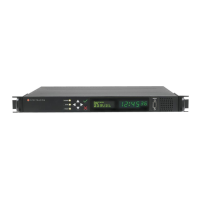Displays log entries related to Input reference state changes (for example, IRIG input is not con
sidered valid), antenna cable status. Examples include:
GRGR = GNSS Reference
1
antenna fault: The GNSS Antenna Problem alarm indicates
the GNSS receiver has detected an over-current or undercurrent condition (an open or
short exists in the GNSS antenna cable, or the GNSS antenna is not connected to
SecureSync). The receiver will attempt to continue the normal acquisition and tracking
process regardless of the antenna status.
GR antenna ok: The antenna coax cable was connected at this time or an open or short
in the antenna cabling was occurring but is no longer being detected.
GPS Qualification Log
If SecureSync is connected to a GNSS antenna and is tracking satellites, this log contains a run
ning hourly count of the number of GNSS satellites tracked each hour. This history data can be
used to determine if a GNSS reception problem exists and whether this is a continuous or inter
mittent reception issue.
GNSS reception may be displayed as cyclic in nature. A cyclic 12 hour pattern of decreased
GNSS reception typically indicates that the GNSS antenna has an obstructed view of the hori
zon. The GNSS satellites are in a 12-hour orbit, so if part of the sky is blocked by large obstruc
tions, at the same time every day (at approximately 12 hour intervals), the GNSS reception
may be reduced or may vanish altogether. If this occurs, the antenna should be relocated to
afford it an unobstructed view of the sky.
Every hour (displayed in the log as UTC time), SecureSync counts the total number of satellites
that were tracked during that hour. The GNSS qualification log shows the number of satellites
that were tracked followed by the number of seconds that the particular number of satellites
were tracked during the hour (3600 seconds indicates a full hour). The number to the left of the
“=” sign indicates the number of satellites tracked and the number to the right of the “=” sign
indicates the number of seconds (out of a total of 3600 seconds in an hour) that the unit was
tracking that number of satellites. For example, “0=3600” indicates the unit was tracking 0 satel
lites for the entire hour, while “0=2700 1=900” indicates the unit was tracking one satellite for
900 seconds, but for the remaining portion of the hour it was tracking zero satellites.
Every hourly entry in the log also contains a quality value, represented by “Q= xxxx” (where x
can be any number from 0000 through 3600). The Qualification log records how many satel
lites were tracked over a given hour. If for every second of the hour a tracked satellite was in
view, the Quality value will equal 3600. For every second SecureSync tracked less than the min
imum number of satellites, the value will be less than 3600. The minimum requirement is one
satellite at all times after the unit has completed the GNSS survey and indicates “Stationary”. A
minimum of four satellites are required in order for the GNSS survey to be initially completed.
If all entries in the qualification log are displayed as “0=3600”, a constant GNSS reception
problem exists, so the cause of the reception issue is continuous. If the unit occasionally shows
0=3600 but at other times shows that 1 through 12 have numbers of other than “0000”, the
reception is intermittent, so the cause of the reception issue is intermittent. If the Quality value
1
GR = GNSS Reference
290
CHAPTER 4 • SecureSync User Reference Guide Rev. 23
4.5 Quality Management

